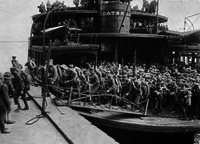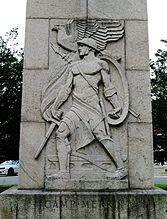
Cresskill is a borough in Bergen County, in the U.S. state of New Jersey. As of the 2020 United States census, the borough's population was 9,155, an increase of 582 (+6.8%) from the 2010 census count of 8,573, which in turn reflected an increase of 827 (+10.7%) from the 7,746 counted in the 2000 census. This town got its name from "Cress", referring to the watercress that grew in its streams, and "Kill", referring to the stream passing through.

The American Expeditionary Forces (AEF) was a formation of the United States Armed Forces on the Western Front during World War I, composed mostly of units from the U.S. Army. The AEF was established on July 5, 1917, in Chaumont, France under the command of then-Major General John J. Pershing. It fought alongside French Army, British Army, Canadian Army, British Indian Army, New Zealand Army and Australian Army units against the Imperial German Army. A small number of AEF troops also fought alongside Italian Army units in 1918 against the Austro-Hungarian Army. The AEF helped the French Army on the Western Front during the Aisne Offensive in the summer of 1918, and fought its major actions in the Battle of Saint-Mihiel and the Meuse-Argonne Offensive in the latter part of 1918.

Camp Upton was a port of embarkation of the United States Army during World War I. During World War II, it was used as an Army induction center, an internment camp for enemy aliens, and a hospital. It was located in Yaphank, New York, in Suffolk County on Long Island, on the present-day location of Brookhaven National Laboratory.
The 366th Infantry Regiment was an all Colored (segregated) unit of the United States Army that served in both World War I and World War II. In the latter war, the unit was exceptional for having all black officers as well as troops. The U.S. military did not desegregate until after World War II. During the war, for most of the segregated units, all field grade and most of the company grade officers were white.
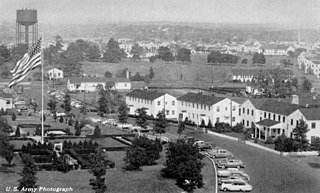
Camp Kilmer is a former United States Army camp in Central New Jersey that was activated in June 1942 as a staging area and part of an installation of the New York Port of Embarkation. The camp was organized as part of the Army Service Forces Transportation Corps. Troops were quartered at Camp Kilmer in preparation for transport to the European Theater of Operations in World War II. Eventually, it became the largest processing center for troops heading overseas and returning from World War II, processing over 2.5 million soldiers. It officially closed in 2009.
Palisades Township was a township that existed in Bergen County, New Jersey, United States. The township was in existence from 1871 to 1922.

The San Francisco Port of Embarkation (SFPOE) was a United States Army command responsible for movement of supplies and troops to and from the Pacific during World War II with extensive facilities in the San Francisco area. SFPOE was established 6 May 1932 and disestablished 1 October 1955. It was originally composed of the long term Pacific terminal at Fort Mason that had been the home port and terminal for the Pacific Army Transport Service ships. That facility was far too limited to serve the requirements of a full port of embarkation. In 1940 the port began expansion to include Army owned and leased facilities throughout the San Francisco Bay area and for a time sub ports at Seattle and Los Angeles. Those eventually became separate commands as the Seattle Port of Embarkation and Los Angeles Port of Embarkation.

The Camp Merritt Memorial Monument is dedicated to the soldiers who passed through Camp Merritt, New Jersey on their way to fight in Europe in World War I, especially the 578 people – 15 officers, 558 enlisted men, four nurses and one civilian – who died at the camp due to the worldwide influenza epidemic of 1918, whose names are inscribed at the base of the monument. The memorial is located at the center of the traffic circle on the borders of Cresskill and Dumont in Bergen County, New Jersey, at the intersection of Madison Avenue and Knickerbocker Road. Camp Merritt was a major embarkation camp which processed more than a million soldiers, and the monument marks its center. Bergen County purchased the property for the site of the monument in 1919.

The New York Port of Embarkation (NYPOE) was a United States Army command responsible for the movement of troops and supplies from the United States to overseas commands. The command had facilities in New York and New Jersey, roughly covering the extent of today's Port of New York and New Jersey, as well as ports in other cities as sub-ports under its direct command. During World War I, when it was originally known as the Hoboken Port of Embarkation with headquarters in seized Hamburg America Line facilities in Hoboken, New Jersey, the Quartermaster Corps had responsibility. The sub-ports were at Boston, Baltimore, Philadelphia and the Canadian ports of Halifax, Montreal and St. Johns. The World War I port of embarkation was disestablished, seized and requisitioned facilities returned or sold and operations consolidated at the new army terminal in Brooklyn. Between the wars reduced operations continued the core concepts of a port of embarkation and as the home port of Atlantic army ships. With war in Europe the army revived the formal New York Port of Embarkation command with the New York port, the only Atlantic port of embarkation, taking a lead in developing concepts for operations.

Cresskill High School is a four-year comprehensive public high school that serves students in ninth through twelfth grades from Cresskill in Bergen County, in the U.S. state of New Jersey, operating as the lone secondary school of the Cresskill Public Schools. The infrastructure is shared with Cresskill Middle School, which serves Cresskill students in sixth through eighth grade.
Dumont High School is a four-year comprehensive public high school that serves students in ninth through twelfth grade from Dumont, in Bergen County, in the U.S. state of New Jersey, operating as the lone secondary school of the Dumont Public Schools.

USS America (ID-3006) was a troop transport for the United States Navy in World War I. She was launched in 1905 as Amerika by Harland & Wolff in Belfast for the Hamburg America Line of Germany. As a passenger liner, she sailed primarily between Hamburg and New York. On 14 April 1912, Amerika transmitted a wireless message about icebergs near the same area where RMS Titanic struck one and sank less than three hours later. At the outset of the war, Amerika was docked at Boston; rather than risk seizure by the British Royal Navy, she remained in port for the next three years.
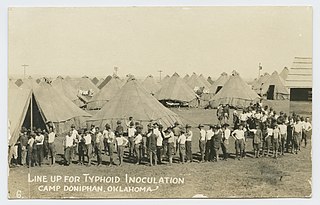
Camp Doniphan was a military base adjacent to Fort Sill, just outside Lawton, in Comanche County, Oklahoma, that was activated for use in World War I for artillery training. The post was closed in 1918 and incorporated into Fort Sill.
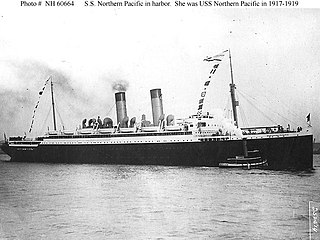
SS Northern Pacific was built as a passenger ship at Philadelphia by William Cramp & Sons under supervision of the Great Northern Pacific Steam Ship Company for the Spokane, Portland and Seattle Railway Company. Northern Pacific, along with sister ship Great Northern, were built to provide a passenger and freight link by sea between the Great Northern Railway Lines and Spokane, Portland and Seattle Railway terminal at Astoria, Oregon and San Francisco beginning in spring of 1915. The ship was acquired on 17 September 1917 for use as a transport ship for the United States Navy during World War I, commissioned USS Northern Pacific and later, after transfer to the United States Army, as the Army transport USAT Northern Pacific. She was destroyed by fire in 1922.

Camp Albert L. Mills was a military installation on Long Island, New York. It was located about ten miles from the eastern boundary of New York City on the Hempstead Plains within what is now the village of Garden City. In September 1917, Camp Mills was named in honor of a former Superintendent of the United States Military Academy at West Point, Major General Albert L. Mills, who had suddenly died the year prior in September 1916. Mills had been awarded the Medal of Honor for gallantry during the Spanish–American War.

Tenafly is a former railroad station located in Tenafly, Bergen County, New Jersey, United States. The station was a stop along Erie Railroad's suburban Northern Branch (NRRNJ) which terminated at Pavonia Terminal on the Hudson River. It stopped being used for passenger rail transport in 1966, by which time trains had been redirected to Hoboken Terminal. The rail line is still used for freight transport by CSX.

Stevedore operations were established by the United States Army to provide movement of supplies through ports in support of the American Expeditionary Forces during World War I. The first American stevedores in France were civilians. Stevedores were originally organized into regiments, and were among the first troops sent to France. Three regiments and two separate battalions were deployed, and were later reorganized into separate battalions and transferred from the Army Service Corps to the Transportation Corps. The battalions were inactivated in France and the troops were assigned to companies without a branch affiliation for their return to the U.S.
The 49th Coast Artillery Regiment was a Coast Artillery Corps regiment in the Regular Army. It was mobilized in World War I, with the searchlight battery mobilized in World War II.

Railway operations were originally established by the United States Army to provide support to France and Great Britain after the United States entered World War I. The Army organized and deployed different types of railway regiments and battalions. As operations progressed, the railway units were used to support the American Expeditionary Forces as well. U.S. rail regiments moved both troops and supplies for the AEF and for the allies from the seaports to the front.

David C. Shanks was a career officer in the United States Army. A graduate of the United States Military Academy, he attained the rank of major general, and was a veteran of the Spanish–American War, Philippine–American War, and World War I. He was most notable for his command of the Hoboken Port of Embarkation and 16th Division during the first World War, and was a recipient of the Army Distinguished Service Medal and Navy Distinguished Service Medal.

